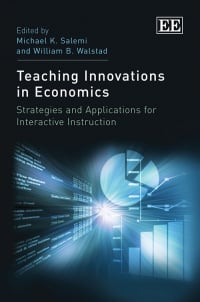Hardback
Teaching Innovations in Economics
Strategies and Applications for Interactive Instruction
9781848448254 Edward Elgar Publishing
Teaching Innovations in Economics presents findings from the Teaching Innovations Program (TIP) funded by the National Science Foundation. The six-year project engaged economics professors in the use of interactive teaching in undergraduate economics courses. Each chapter offers an insightful explanation of an innovative teaching strategy and provides a description and examples of its effective use in undergraduate economics courses. The book’s conclusion assesses the results from an evaluation of the program that reports detailed findings on how TIP fundamentals have contributed to faculty development and successful outcomes.
More Information
Contributors
Contents
More Information
Teaching Innovations in Economics presents findings from the Teaching Innovations Program (TIP) funded by the National Science Foundation. The six-year project engaged economics professors in the use of interactive teaching in undergraduate economics courses. Each chapter offers an insightful explanation of an innovative teaching strategy and provides a description and examples of its effective use in undergraduate economics courses. The book’s conclusion assesses the results from an evaluation of the program that reports detailed findings on how TIP fundamentals have contributed to faculty development and successful outcomes.
The first three chapters of the book describe the results of TIP’s three phases: (1) workshops on teaching for college and university economics instructors that introduced them to a variety of interactive teaching strategies; (2) follow-on instructional modules that provided mentoring from interactive strategy experts and gave participants an opportunity to adapt and apply these strategies to their undergraduate economics courses; and (3) opportunities to contribute to the scholarship of teaching and learning in economics, which involves sharing and discussing teaching innovations with other faculty members in presentations, papers, and other forums. The chapters following describe the seven interactive strategies featured in the project: cooperative learning, classroom experiments, interpretive discussion, formative assessment, context-rich problem solving, teaching with cases, and active learning in large-enrollment courses. These seven chapters were each written by a team of four economists, consisting of a strategy expert and three TIP participants who used the teaching strategy in their classrooms with students.
Written by economists and for economists, this is a valuable resource for all undergraduate economics instructors who seek to enrich their teaching and engage their students in employing economics theory and practice in the classroom and beyond.
The first three chapters of the book describe the results of TIP’s three phases: (1) workshops on teaching for college and university economics instructors that introduced them to a variety of interactive teaching strategies; (2) follow-on instructional modules that provided mentoring from interactive strategy experts and gave participants an opportunity to adapt and apply these strategies to their undergraduate economics courses; and (3) opportunities to contribute to the scholarship of teaching and learning in economics, which involves sharing and discussing teaching innovations with other faculty members in presentations, papers, and other forums. The chapters following describe the seven interactive strategies featured in the project: cooperative learning, classroom experiments, interpretive discussion, formative assessment, context-rich problem solving, teaching with cases, and active learning in large-enrollment courses. These seven chapters were each written by a team of four economists, consisting of a strategy expert and three TIP participants who used the teaching strategy in their classrooms with students.
Written by economists and for economists, this is a valuable resource for all undergraduate economics instructors who seek to enrich their teaching and engage their students in employing economics theory and practice in the classroom and beyond.
Contributors
Contributors: J. Bangs, N.-H. Blunch, P. Conway, M. Curme, A.E. Davis, T.L.N. Emerson, I. Ghosh, M. Hartmann, D. Hazlett, G. Hoyt, J. Imazeki, P. Joshi, M. Kassis, K. Madden, M. Maier, K. McGoldrick, R. O’Sullivan, K.A. Paulson Gjerde, B. Peterson, R. Rebelein, J.K. Rhoads, M.K. Salemi, J.J. Siegfried, K. Silz Carson, J.A. Smrha, D. Stimel, S. Stockly, J.J. Vazquez-Cognet, D. Vera, W.B. Walstad
Contents
Contents:
Foreword
John J. Siegfried
Preface
1. Developing Teacher Expertise for Economists through a Workshop Experience
Michael K. Salemi
2. Online Faculty Instruction to Improve Interactive Teaching of Economics
Mark Maier and Tisha L.N. Emerson
3. Advancing the Scholarship of Teaching and Learning in Economics
KimMarie McGoldrick
4. Making Cooperative Learning Effective for Economics
KimMarie McGoldrick, Robert Rebelein, Jennifer K. Rhoads and Sue Stockly
5. Conducting Experiments in the Economics Classroom
Denise Hazlett, Kathy A. Paulson Gjerde, José J. Vazquez-Cognet and Judith A. Smrha
6. Classroom Discussion
Michael K. Salemi, Kirsten Madden, Roisin O’Sullivan and Prathibha Joshi
7. Formative Assessment in Economics Courses
William B. Walstad, Michael Curme, Katherine Silz Carson and Indradeep Ghosh
8. Context-rich Problems in Economics
Mark Maier, Joann Bangs, Niels-Hugo Blunch and Brian Peterson
9. Case Use in Economics Instruction
Patrick Conway, Derek Stimel, Ann E. Davis and Monica Hartmann
10. Interactive Large Enrollment Economics Courses
Gail Hoyt, Mary Kassis, David Vera and Jennifer Imazeki
11. Findings from a Teaching Innovation Program for Economics Faculty
William B. Walstad
Index
Foreword
John J. Siegfried
Preface
1. Developing Teacher Expertise for Economists through a Workshop Experience
Michael K. Salemi
2. Online Faculty Instruction to Improve Interactive Teaching of Economics
Mark Maier and Tisha L.N. Emerson
3. Advancing the Scholarship of Teaching and Learning in Economics
KimMarie McGoldrick
4. Making Cooperative Learning Effective for Economics
KimMarie McGoldrick, Robert Rebelein, Jennifer K. Rhoads and Sue Stockly
5. Conducting Experiments in the Economics Classroom
Denise Hazlett, Kathy A. Paulson Gjerde, José J. Vazquez-Cognet and Judith A. Smrha
6. Classroom Discussion
Michael K. Salemi, Kirsten Madden, Roisin O’Sullivan and Prathibha Joshi
7. Formative Assessment in Economics Courses
William B. Walstad, Michael Curme, Katherine Silz Carson and Indradeep Ghosh
8. Context-rich Problems in Economics
Mark Maier, Joann Bangs, Niels-Hugo Blunch and Brian Peterson
9. Case Use in Economics Instruction
Patrick Conway, Derek Stimel, Ann E. Davis and Monica Hartmann
10. Interactive Large Enrollment Economics Courses
Gail Hoyt, Mary Kassis, David Vera and Jennifer Imazeki
11. Findings from a Teaching Innovation Program for Economics Faculty
William B. Walstad
Index




